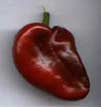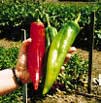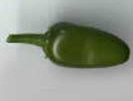Home | FOOD ARTICLES | Food Trivia | Today_in_Food_History | Food_History_Timeline | Recipes | Cooking_Tips | Food_Videos | Food_Quotes | Who’s_Who | Culinary_Schools_&_Tours | Food_Trivia_Quizzes | Food_Poems | Free_Magazines | Food_Festivals_and_Events
Food Articles, News & Features Section
FREE Magazines
and other Publications
Free Professional and Technical Research, White Papers, Case Studies, Magazines, and eBooks
CHILI PEPPERS
See also: Why are Chili Peppers Hot?; Chili Pepper Trivia; Poblanos;
Chiles, Some Like It Hot
Hot peppers (chilies) are often used to spice up dishes, and they are especially popular in ethnic cuisine including Mexican, Indian, Thai, Vietnamese, Arab and Spanish cooking. Chilies are an excellent source of vitamin C if you can withstand their powerful bite.
Contrary to popular belief, the hottest part of the chili pepper is not the seeds but where the seed attaches to the white membrane inside the pepper. This area has the highest concentration of capsaicinoids. Capsaicinoids are flavorless, odorless substances that act on pain receptors in the mouth and throat. Capsaicin is the primary capsaicinoid. Capsaicinoids can be found throughout the flesh of chili peppers though their concentration varies in different areas so that one part of a pepper may be hot and another part of the same pepper quite mild.
The seeds are often hot because they are in such close contact with the white membrane.
There are several varieties of chili peppers (see box below) and each differs in flavor and heat intensity. Even within each variety, there may differences in how “hot” each particular chili is. Typically, larger chilies are more mild because they contain less seeds and white membrane in proportion to their size. Most varieties can be found dried, canned, or fresh.
VARIETIES
 Anaheim (California Green Chile or Long Green Chile):
Anaheim (California Green Chile or Long Green Chile):
One of the most commonly used varieties in the United States, especially in stuffed chiles. This chili is long, slender and lobed, green or red in color and mildly hot. They can be eaten when green or when they are their mature red color.
 Ancho: Dried or fresh poblano pepper.
Ancho: Dried or fresh poblano pepper.
Dried anchos are flat, wrinkled, and heart shaped. They range in color from very dark red to almost black. Anchos are mild to moderately hot and often soaked and ground for use in sauces.
Cascabel:
Green or red, small and round, moderately hot and typically available dried. When dried, their skin turns a translucent red-brown color and their seeds rattle inside.
 Cayenne (Long Hots):
Cayenne (Long Hots):
Red when fully mature, long (6 to 10 inches), thin and straight or curled at the tips. Very hot. Cayenne can be found dried and ground into a powder that is seen as generic "red pepper" in the spice aisle.
Cherry: Round and red like a cherry. Sold fresh or pickled in jars, these peppers range from mild to moderately hot.
Habanero (Scotch Bonnet): Typically yellow-orange but they can be green, red, or orange. These peppers are lantern shaped and typically about 2 inches long. The hottest pepper grown commercially; intense fiery flavor; a unique floral flavor and an extremely intense heat that affects the nasal passages.
Hungarian: These peppers start out yellow and ripen to orange or red; they are moderately hot.
 Jalapeńo: Most often green when mature but sometimes red, these peppers are about 2 inches in length with cracks around their stems. They are very hot, with an immediate bite. Jalapeńos are sold canned, sliced, and pickled and are added to many products during processing including sausage, cheese, and jelly.
Jalapeńo: Most often green when mature but sometimes red, these peppers are about 2 inches in length with cracks around their stems. They are very hot, with an immediate bite. Jalapeńos are sold canned, sliced, and pickled and are added to many products during processing including sausage, cheese, and jelly.
Poblano: Ancho peppers that are green. Poblano peppers look like small bell peppers and are mild to hot in taste. They are often roasted and peeled prior to being used in soups, sauces, casseroles or even stuffed with meat and cheese for a dish called chilies rellenos.  Serrano: Sold red or mature green and about 1 to 4 inches in length. Moderate to very hot with an intense bite. Serrano chilis are often used in Thai cooking and they are also quite popular in Mexico and the southwestern United States.
Serrano: Sold red or mature green and about 1 to 4 inches in length. Moderate to very hot with an intense bite. Serrano chilis are often used in Thai cooking and they are also quite popular in Mexico and the southwestern United States.
Availability, Selection, and Storage
Chili peppers are available year round and in the United States they are grown in California, New Mexico and Texas. When selecting chilies, look for firm, glossy chilies with taut, unwrinkled skin and fresh green stems. Dried hot peppers should be glossy yet unbroken.
Chilies should be stored unwashed and wrapped in paper towels in the refrigerator for up to three weeks. Dried chilies should be stored in airtight containers at room temperature for a maximum of four months. To keep dried chilies for more than four months, store them in the refrigerator.
Preparation
 It is very important not to touch your nose, eyes or mouth after handling or eating hot peppers. If you do, flush with water immediately. The capsaicin in the peppers can be extremely painful to your eyes and can even burn or irritate your skin (especially if you have cuts on your hands).
It is very important not to touch your nose, eyes or mouth after handling or eating hot peppers. If you do, flush with water immediately. The capsaicin in the peppers can be extremely painful to your eyes and can even burn or irritate your skin (especially if you have cuts on your hands).
If possible, wear thin rubber gloves while preparing chili peppers. Wash hands thoroughly with soap and water when done working with chilies. If the bite is too strong when you eat a chili, chew on bread or another starchy food; water only makes the bite worse as it spreads it.
To decrease the heat intensity of chilies, wash them, cut them open and remove the seeds and veins. Also, soaking cut up chilies in salt water for at least an hour will help cool them off.
To add a mild pepper flavor to your dish, poke holes in the chili of your choice with a toothpick (or cut slits in it) and add it to a food that is already cooking. When cooking is complete, remove the chili from the dish.
Chilies can also be roasted whole over a gas stove, broiler, or on a grill. Use a cooking fork to hold each pepper over flame. Turn frequently until the chili’s skin is blackened. After cooking is complete, place chilies in a paper or plastic bag for 15 minutes. Scrape off skin, cut off stem and pull out core. Scrape any remaining seeds.
Preparing Dried Hot Peppers
Use a damp cloth to wipe peppers. Grind chilies in a food processor for use as chili powder. To soften their texture and make their flavor more mild, soak chili peppers in water prior to using.
Make Chili Peppers Part of Your 5 A Day Plan
- Cut up and add to pizza as a topping!
- Dice and add to your favorite salsa recipe or any store bought salsa.
- Chop finely and add to salads.
- Serve as a garnish next to a meal and eat the garnish!
- Add to stews and soups for a stronger flavor.
- Sprinkle chopped hot peppers into meat loaf, tomato sauce or macaroni and cheese.
- Cook in corn bread for a zesty jalapeńo corn bread.
RELATED ARTICLES
Please feel free to link to any pages of FoodReference.com from your website.
For permission to use any of this content please E-mail: james@foodreference.com
All contents are copyright © 1990 - 2025 James T. Ehler and www.FoodReference.com unless otherwise noted. All rights reserved.
You may copy and use portions of this website for non-commercial, personal use only.
Any other use of these materials without prior written authorization is not very nice and violates the copyright.
Please take the time to request permission.

